Bear H.S. Understanding Calculus
Подождите немного. Документ загружается.


43
Exact Differentials
SupposeF(x, y) is defined in someregionR, and
dF(x,y) =P(x,y) dx + Q(x,y) dy;
(43.1)
that is, assume
thatP(x,y) =Fx(x,y) and Q(x,y) =Fy(x,y). In this casewe saythatPdx +Qdy
is an exact differential in the regionR. Line integralsare particularlysimple if the differen-
tial is exact.
To evaluate
Ie
Pdx + Qdy where the differential is exact as in (43.1), we let C be a
curve inR from
(a, b) to (c, d), with Cparameterized by
x =x(t), Y =y(t), a
=::;
t
=::;
11
(43.2)
Thus (x(a), y(a» = (a, b) and
(x(f3),
y(f3»
= (c, d), and the integral is evaluated as
follows:
1
Pdx + Qdy=
JI3[F
(x(t),y(t»x'(t)
+ F (x(t),y(t»y'(t)] dt. (43.3)
C a x y
If we let G(t) =F(x(t), y(t», then the integrandon the right in (43.3)is just G'(t), so
1Pdx + Qdy = rG'(t) dt
C a
=
G(f3)
- G(a)
=
F(x(f3),
y(f3»
- F(x(a), y(a»
=F(c,
d)-F(a,
b). (43.4)
In otherwords,if Pdx + Qdy= dF, then for any curve C from (a, b) to (c, d),
Lp(X,
y) dx + Q(x,
y)
dy =F(c, d) - F(a, b).
(43.5)
267

268
Understanding Calculus
Wecan also write (43.5)as
l
(C' d)
. dF =F(c, d) - F(a, b)
(a, b)
(43.6)
(43.7)
to emphasizethe similaritywith one-variable integration. For an exact differential, the line
integralis independent of path, and dependsonly on the end points of the curve.
EXAMPLE
43.1
Giventhat 2xy dx +(x
2
+
3y2)
dy is exact,find a functionF(x, y) such that dF(x,y) is the differential,
anduse
F(x,y) to calculate fc2xy dx + (x
2
+
3y2)
dy whereC is the arc of the circle(x - 2)2+ (y -
1)2
= 1
from(2, 2) to (3, 1).
Solution
SinceFx(x,y) = 2xy,F(x,y) is the x-antiderivative of2xy:
F(x,y)
= f
2xydx=x
2y+CP(Y).
Herey is consideredconstant, and the arbitraryfunction
CP(Y)
is a "constant of integration". Now use
Fy(x,
y) = Q(x,y):
a
Fix,y)
=
ay
[xly +
CP(Y)]
= xl +
cp'(Y);
Q(x,y)
=x
2
+
3y2.
Hence
cp'(y)
=
3y2,
CP(Y)
= y.
Finally,
F(x,y)
=x
2y
+ y.
(43.8)
(43.9)
Now to calculatethe line integral,we forgetabout the curve C, and just evaluate F(x, y) at the
endpoints:
l2xy
dx+(xl +
3y2)
dy = F(3, 1) - F(2, 2)
c
= 3
2
•
1 + 1- (2
2
•
2 + 2
3
)
=
10-16
=-6.
Nowthe questionarises:how do we knowwhethera differential Pdx + Qdy is exact or
not? There is an obviousnecessary condition. If P(x, y)
=
Fx(x,
y) and Q(x,y) =
Fy(x,
y), then
we must have
P=F
=F
=Q.
y xy
yx
x
If Pdx
+ Qdy is exact, then Q
x
= P
y'
It turns out that the condition Q
x
= P
y
is also sufficient
for Pdx
+Qdy to be exact,at least with a little quibblingaboutthe geometryof the region.
If Q
x
= P
y
in the whole plane, then the integral of Pdx + Qdy will be independent of
path. To see this, let C
1
and C
2
be two curves from (a, b) to (c, d), then C
1
-
C
2
is a closed
curve (Figure43.1), and since
Q
x
-
P
y
==
0 inside C
1
-
C
2
,
the line integralaroundthe bound-
ary curve is zero by Green'sTheorem. That is,
I Pdx +Qdy=I Pdx + Qdy
C
1
C
2
for any two curves with the same end points. If C
1
and C
2
intersect each other on the way
from
(a, b) to (c, d), then we apply Green's Theorem to each loop (Figure43.2) and get the
sameresult.
If Q
x
=P
y
so that the integralof Pdx + Qdy is independentof path, then we can define
a functionF(x,
y) by

Chapter43 • ExactDifferentials
Figure 43.1
• (c, d)
269
I
(x,y)
F(x, y) = P(x, y) dx +Q(x, y) dy,
(a,b)
where
(a, b) is anyfixedpoint.Forthis
function,
Fx(x,y) =P(x, y) andFy(x,y) =Q(x, y), so
dF(x,y) =
P(x,y)
dx+
Q(x,y)
dy.
EXAMPLE43.2
Checkthat
(ye
+xy
e)
dx +
(xe
+2y) dy is exact,and evaluate
1
(3,1)
(ye
+
xye)
dx +
(xe
+2y) dy
(1,2)
overany curve from (1, 2) to (3, 1).
Solution
Wecheckthe conditionQ
x
= P
y
:
a
Qx(x,
y) =
ax
(xe
+2y) =e +xe',
a
Py(x, y) =
ay
(ye
+
xye)
= e +xe'.
SinceQ
x
= P
y
the differential is exact.
Figure 43.2
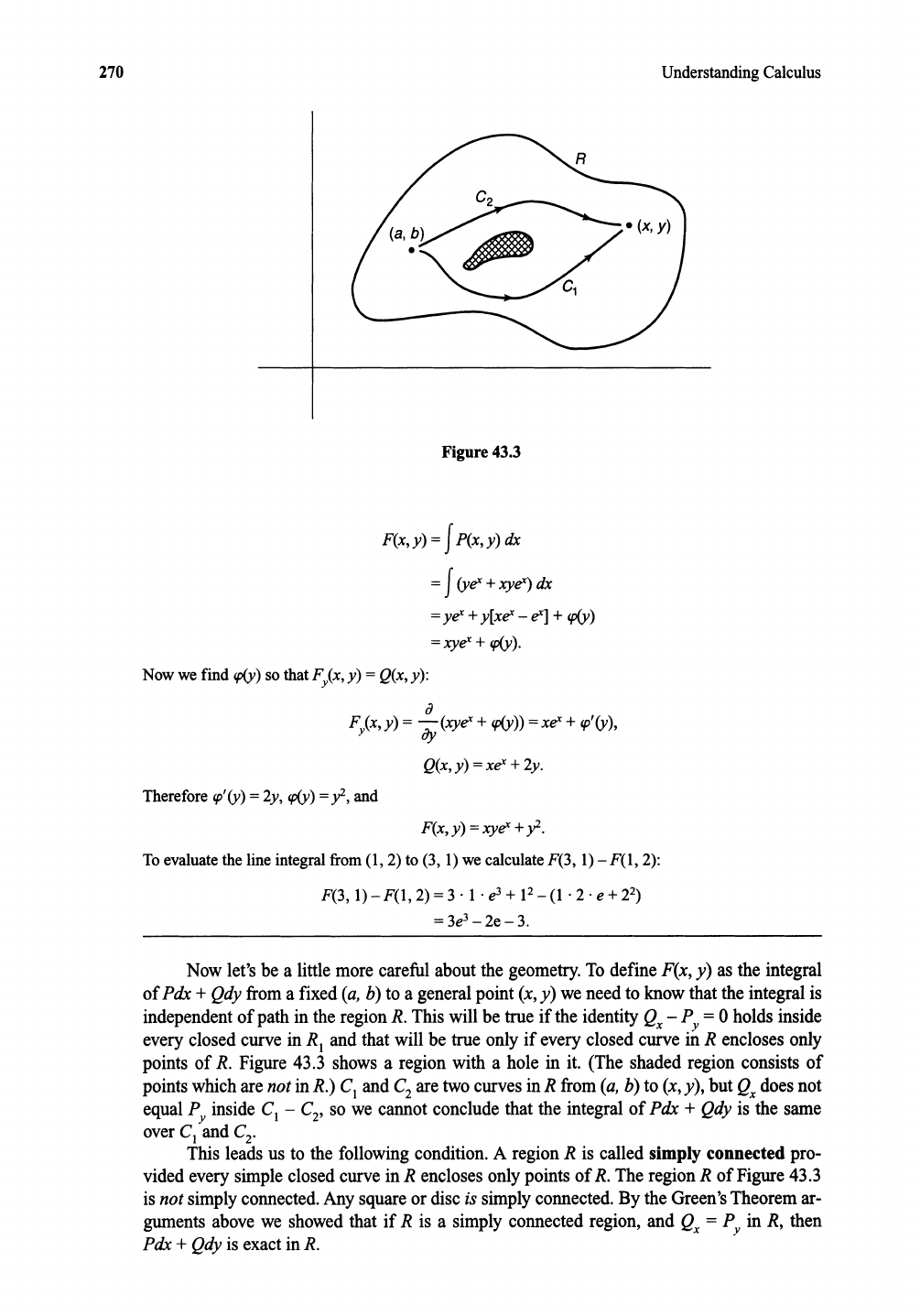
270
Understanding Calculus
Figure
43.3
F(x,y) = JP(x,y) dx
= J
(yex
+
xyex)
dx
=ye' +
y[xeX
-
eX]
+
CP(Y)
=
xyeX
+
CP(Y).
Now we find
CP(Y)
so that Fy(x,y) = Q(x,y):
a
F (x,y) =
-(xyeX
+
CP(Y))
<xe'
+
cp'(y),
y
ay
Q(x,y) =
xe'
+ 2y.
Therefore
cp'
(y) = 2y,
CP(Y)
=
y2,
and
F(x,y) =xyeX+
y2.
To evaluate the line integral from (1, 2) to (3, 1) we calculate F(3, 1) - F(I, 2):
F(3,
1)
-F(I,
2) = 3
·1
. e
3
+ 1
2
-
(1
·2·
e + 2
2
)
=3e
3-2e-3.
Now let's be a little more careful about the geometry. To define F(x,y) as the integral
of
Pdx + Qdy from a fixed
(a,
b) to a generalpoint (x, y) we need to know that the integral is
independent of path in the region
R. This will be true if the identityQ
x
-
P = 0 holds inside
every closed curve in R, and that will be true only
if
every closed curve
J;.
R encloses only
points of
R. Figure 43.3 shows a region with a hole in it. (The shaded region consists of
pointswhichare
not in R.) C
1
and C
2
are two curves inR from
(a,
b) to (x,y), but Q
x
doesnot
equal
P
y
inside C
1
-
C
2
,
so we cannot conclude that the integral of Pdx + Qdy is the same
over
C
1
and C
2
•
This leads us to the following condition. A region R is called simply connected pro-
vided every simpleclosed curve in
R enclosesonly points of R. The region R of Figure43.3
is
not simplyconnected. Any square or disc is simplyconnected. By the Green'sTheoremar-
guments above we
showed
that if R is a simply connected region, and Q
x
= P
y
in R, then
Pdx + Qdy is exact in R.

Chapter43 • ExactDifferentials
271
EXAMPLE
43.4
Let C
1
be the top half of the unit circle from (1, 0) to (-1, 0), and let C
2
be the bottomhalf of the unit
circlefrom(1,0) to (-1, 0). Calculate
feR
dx+~
dyforeach of the curves C
1
and C
2
•
Solution
It is easy to check (Problem 9) that Q
x
= P
y
at all points where both P and Q are defined; i.e., at all
(r, y) except(0, 0). Sincethe originlies insidethe closedcurveC
1
-
C
2
wecannotconcludethatthe two
integrals are the same. To calculate the line integrals we parameterize the circle with
x = cos 6,
y = sin 6.On C
1
,
0 goes from 0 to 11', and on C
2
, 0 goes from0 to
-11'.
f
-y
x
2"":2
dx +
2"":2
dy
c
1
X
+Y x +r
i1
-sin 6 cos 6 ]
=
20·
20
(-
sin 6)+ 20 . 2 a (cos 6)
dO
o cos + sm cos + sm u
i1
sin
20
cos
26
]
=
--+--
dO
o 1 1
Withthe same algebrawe get
f
-y
X
i-71'
2"":2
dx +
2"":2
dy =
dO
=
-11'.
c
2
X +Y x +r 0
The integralsare indeeddifferent. Theplane withthe originpuncturedout is not simplyconnected.
EXAMPLE
43.5
Solvethe exactdifferential equation
Solution
Wewritethe equationin the form
dy =
dx
logy +
yeX
x .
-+
eX+
3y2
y
(log y +yex)dx+
(~
+ ex+
3y2
) dy = 0
and checkthat the differential is exact.
a 1
ay
(logy +
yeX)
= Y+ e',
a
(x
) 1
- - +eX+3y2 = - +
eX.
ax y y
The differential is exactin the upperhalf plane (wherelogy and x-yare defined),so
F(x,y) = f(logy +yex)dx
= x logy +ye' +
CP(Y).
Tofind
CP(Y),
calculate
Fy(x,
y):
x
F (x,y) = - +
eX
+
lp'(Y),
y y
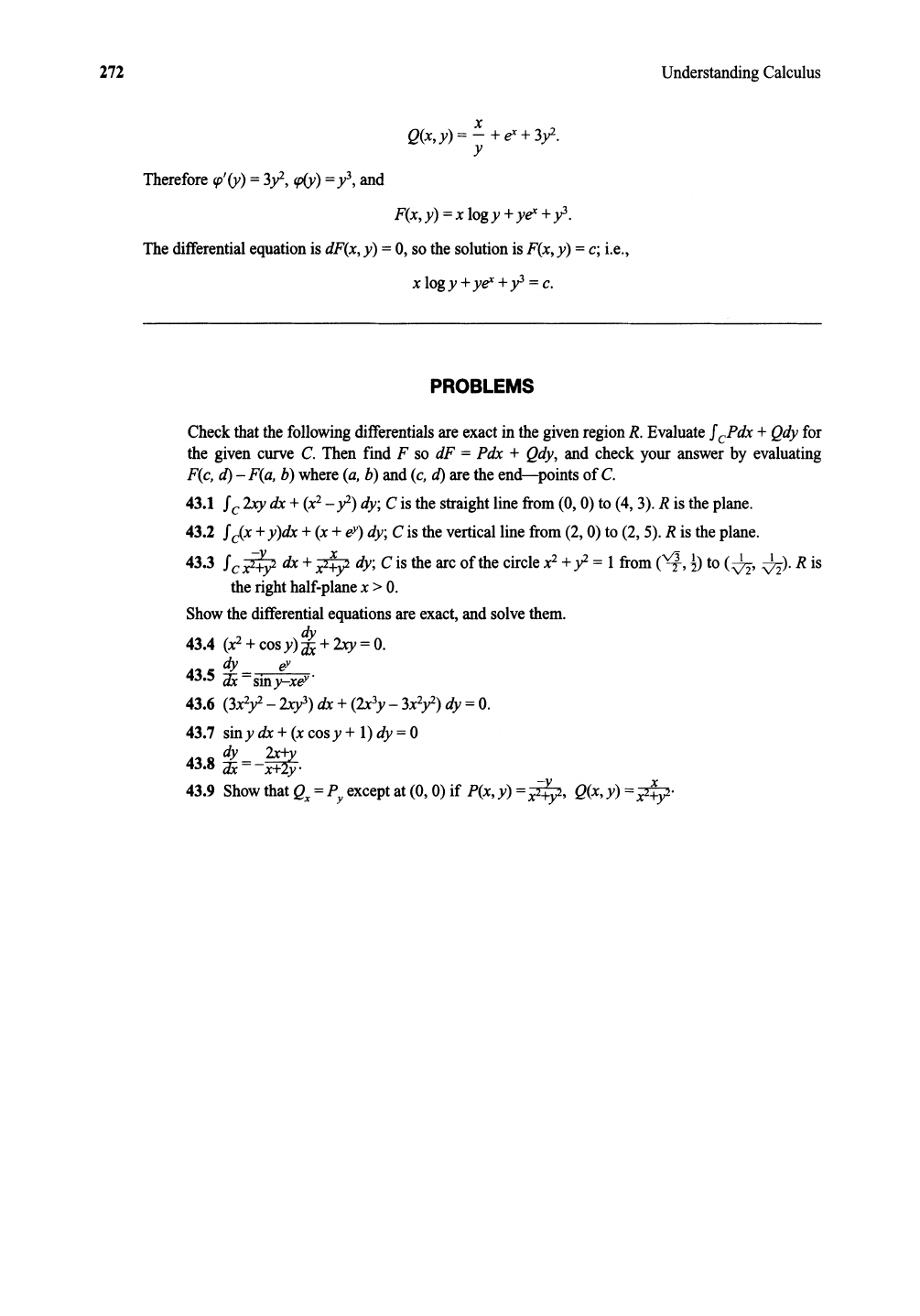
272
Understanding Calculus
x
Q(x,y)
= -
+e+3y2.
y
Therefore
q/(y)
=
3y,
lp(y)
= y3, and
F(x,y)
=x
logy +
ye
+I.
The differential equationis dF(x, y) =0, so the solutionis F(x, y) =c; i.e.,
x logy + ye' + 1= c.
PROBLEMS
Checkthat the following differentials are exact in the givenregionR. Evaluatef
cPdx
+Qdy for
the given curve C. Then find
F so dF = Pdx + Qdy, and check your answer by evaluating
F(c, d) - F(a, b) where(a, b) and (c, d) are the end-points of C.
43.1
f c 2xy dx + (x
2
-
y) dy; C is the straightline from (0, 0) to (4, 3).R is the plane.
43.2
fc(x +y)dx + (x +e
Y
)
dy; C is the verticalline from(2,0) to (2, 5). R is the plane.
43.3
fc
XZ~?
dx +
~
dy; C is the arc of the circlex
2
+
y2
= 1 from
("4,
~)
to
(~,
~).
R is
the right half-plane
x >
O.
Showthe differential equationsare exact,and solvethem.
dy
43.4 (x
2
+cosy)
ax
+2xy =
O.
dy e
Y
43.5
ax
= SID y-xeY.
43.6 (3x
2
y2
-
2xI)
dx + (2x
3
y - 3x
2
y2
)dy =
O.
43.7
sinydx+(xcosy+
l)dy=O
dy
~
43.8
ax
=
-x+
y'
43.9 Showthat Q
x
= P
y
exceptat (0, 0) if P(x, y) = xi.Jy, Q(x,y) =
X2~YZ'
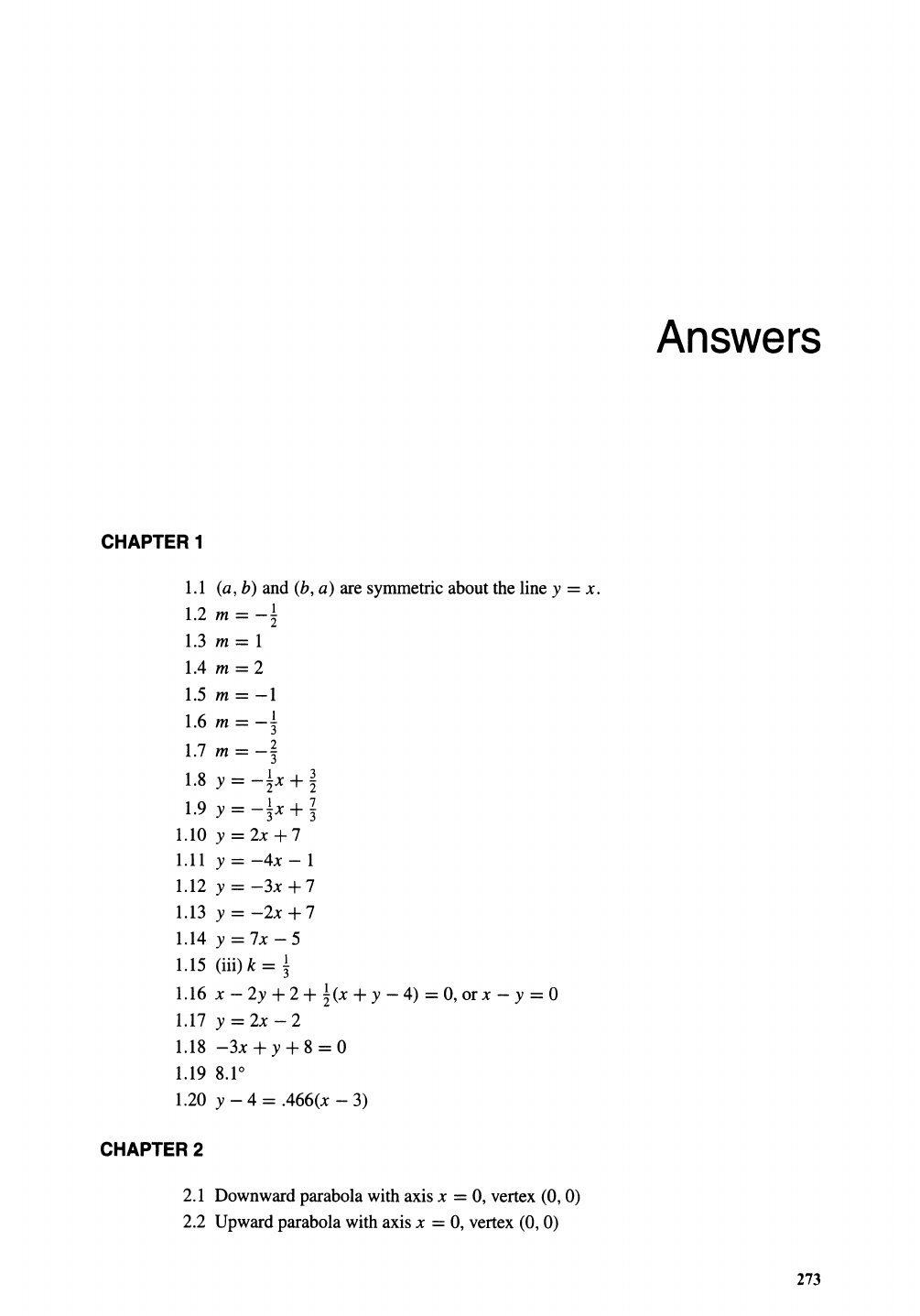
CHAPTER
1
1.1 (a, b) and (b, a) are symmetric about the line y = x.
1.2 m
=-~
1.3 m = 1
1.4 m = 2
1.5 m =
-1
1.6 m
=-1
1.7 m
=-~
1
8
-
1 3
. Y -
-2
x
+ 2
1.9 y =
-~x
+
~
1.10 y = 2x + 7
1.11 y =
-4x
- 1
1.12 y =
-3x
+7
1.13 y =
-2x
+7
1.14
y=7x-5
1.15 (iii) k =
~
1.16 x - 2y + 2 +
~(x
+ y - 4) = 0, or x - y = 0
1.17
y=2x-2
1.18
-3x
+ y + 8 = 0
1.19 8.1
0
1.20 y - 4 = .466(x - 3)
CHAPTER
2
2.1 Downward parabola with axis x = 0, vertex (0, 0)
2.2 Upward parabola with axis
x = 0, vertex (0, 0)
Answers
273

274 Answers
2.3 Upward parabola with axis x = 0, vertex (0, 0)
2.4 Upward parabola with axis
x =
-1,
vertex (
-1,
0)
2.5 Upward parabola with axis
x = 0, vertex (0, 1)
2.6 Downward parabola with axis
x = 0, vertex (0, 1)
2.7 Upward parabola with axis
x = 1, vertex (1, 1)
2.8 Downward parabola with axis
x = 1, vertex (1, 1)
2.9 Circle with center (0, 0), radius 2
2.10 Circle with center
(1,0),
radius 1
2.11 Circle with center (0, 2), radius 3
2.12 Ellipse through
(±3,
0) and (0,
±2)
2.13 Ellipse through
(±1,
0) and (0,
±2)
2.14 Ellipse through
(±3,
0) and (0,
±2)
2.15 Hyperbola through
(±1,
0), asymptotes y = ±x
2.16 Hyperbola through (0,
±1),
asymptotes y = ±x
2.17 Hyperbola through
(J2,
J2)
and
(-J2,
-J2),
asymptotes x = 0 and y = 0
2.18 Hyperbola through (2, 1) and (0,
-1),
asymptotes y = 0 and x = 1
2.19 x
2
+ y2 - 2x + 4y = 0
2.20 y =
1(x
+ 1)2
CHAPTER 3
3.1 4
3.2 20
3.3 27
3.4 6
3.5 !
3.6 !
3.7
-b
3.8
-2
3.9 n
3.10
y-2=4(x-l)
3.11
y-l=-4(x-2)
3.12
y-4=~(x-4)
3.13 y - 1 =
-~(x
- 1)
3.14 s'(2) = 36 ft/sec; s' (0) = 100 ft/sec; max height = 156.25 ft
3.15
s(2)
= 104;
s'(2)
= 84 ftlsec
3.16
~~
= 4Jrt
2
3.17 W'(100) =
-to
lb/min
CHAPTER 4
4.1
~
= 20x
3
+ 2x + 1
4.2
~~
=
-6x
+
~
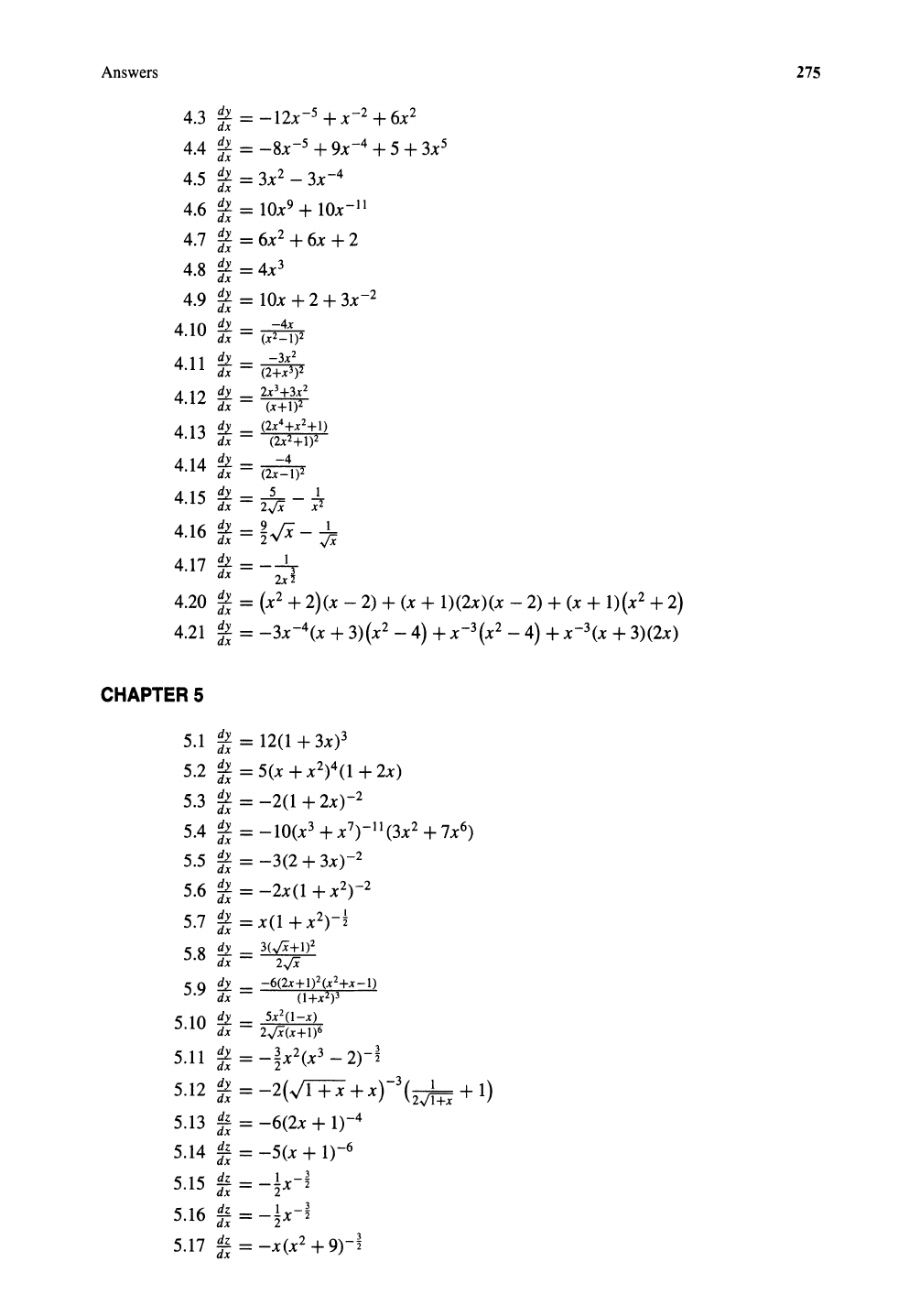
Answers
4.3
~~
=
-12x-
s
+x-
2
+6x
2
4.4
~~
=
-8x-
s
+
9x-
4
+ 5 + 3x
s
4.5
~
= 3x
2
-
3x-
4
4.6
~
= 10x
9
+
10x-
ll
4.7
~
=6x
2+6x+2
4.8
~
= 4x
3
4.9
~
= lOx + 2 +
3x-
2
4
10
dy -
-4x
•
dx
- (x
2_1)2
4 11
dy _
-3x
2
•
dx
-
(2+x
3)2
4 12 dy _ 2x
3+3x
2
•
dx
-
(x+1)2
4 13
~
- (2x
4+x
2+1)
·
dx
- (2x
2+1)2
414
~
-4
·
dx
=
(2x-1)2
415
~
- S 1
•
dx
-
2,Ji
- XI
4 16
~
=
2.
~x
- -.L
· dx 2
'\I
A
,Ji
4.17
~dd
=-~
x
2x~
4.20
~
= (x
2
+ 2)(x - 2) + (x + 1)(2x)(x - 2) + (x + 1)(x
2
+ 2)
4.21
~
=
-3x-
4(x
+ 3)(x
2
- 4) +
x-
3(x2
-
4) +
x-
3(x
+ 3)(2x)
CHAPTER
5
5.1
~~
= 12(1 + 3x)3
5.2
~
= 5(x + x
2)4(1
+ 2x)
5.3
~
=
-2(1
+ 2x)-2
5.4
~~
=
-10(x
3
+x
7)-11(3x
2
+7x
6
)
5.5
~~
=
-3(2
+ 3x)-2
5.6
~
=
-2x(1
+ x
2)-2
5.7
~~
= x(1 + x
2
)- 4
5 8 dy _
3(,Ji+
1)2
•
dx
-
2,Ji
5 9
~
-
-6(2x+1)2(x
2+x-1)
. dx - (1
+x
2
)3
5 10
~
- 5x
2(l-x)
• dx -
2,Ji(x+
1)6
5.11
~
=
_~x2(x3
-
2)-~
5.12
~~
=
-2(.JI+X
+xr
3
(2k + 1)
5.13
~~
=
-6(2x
+ 1)-4
5.14
~~
=
-5(x
+ 1)-6
5
15
d:
1_1
•
dx
=
-2'X
2
5 16
dz
1_1
•
dx
=
-2'X
2
5.17
~~
=
-x(x
2
+
9)-~
275
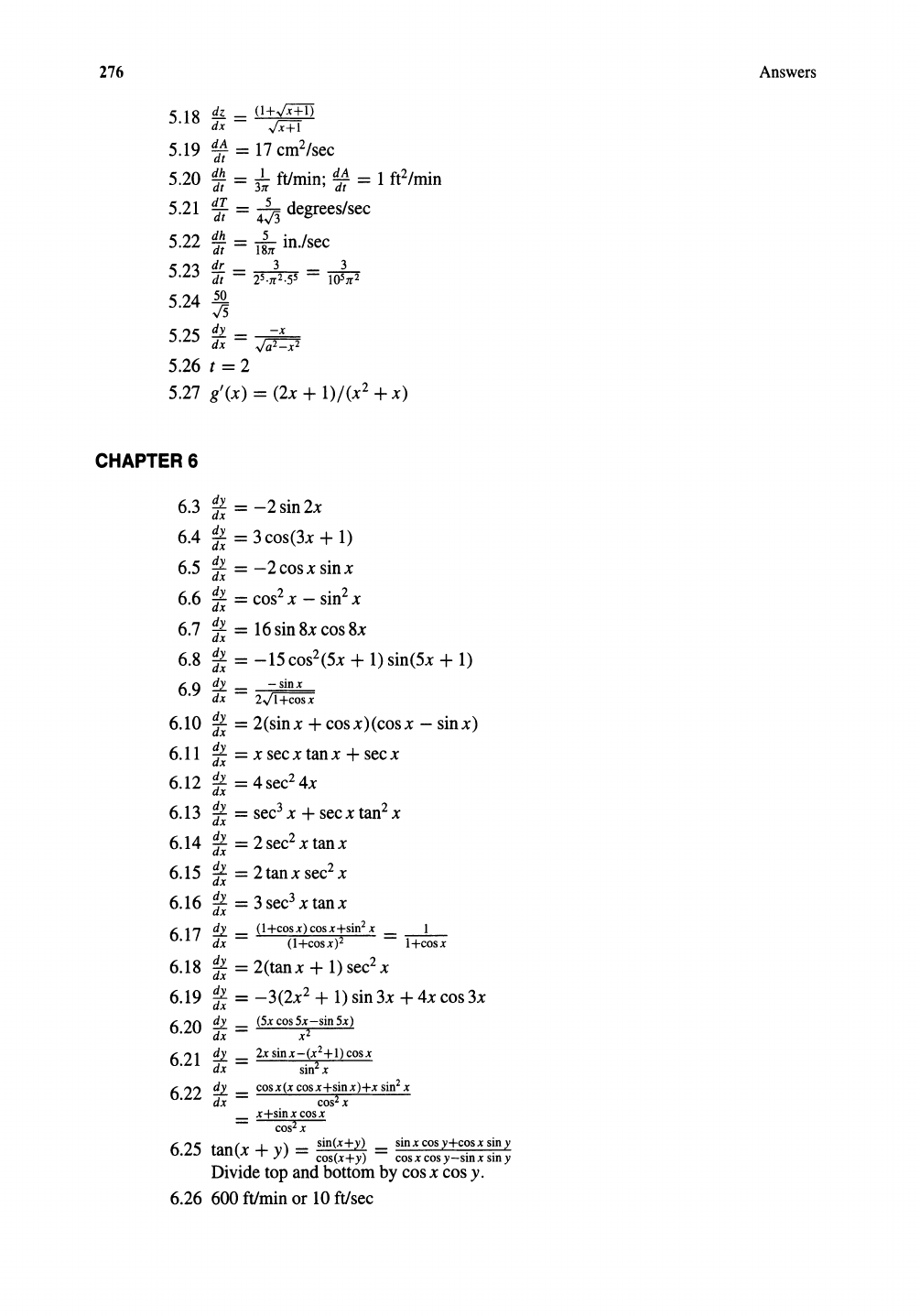
276
5
18
dz -
(l+JX+ij
· dx -
JX+T
5.19
~~
= 17 cm
2/sec
5.20
~;
=
3~
ft/min;
~~
= 1 ft
2/min
5 21
dT 5 d /
·
dt
=
4J3
egrees sec
5 22
dh
5·
/
• dt = 18Jr In. sec
5 23
[ft. -
_3_
-
_3_
· dt - 2
5
.Jr2·5
5
- 10
5
Jr2
5.24
~
5 25 dy
-x
· dx = Ja
2
- x
2
5.26 t = 2
5.27 g'(x) = (2x +
1)/(x
2
+ x)
CHAPTER
6
6.3
~~
=
-2
sin 2x
6.4
~~
= 3 cos(3x + 1)
6.5
~~
=
-2cosx
sinx
6.6
~~
= cos
2
X - sin
2
x
6.7
~~
= 16 sin 8x cos 8x
6.8
~~
=
-15
cos
2(5x
+ 1) sin(5x + 1)
6
9
~
-
-sinx
. dx -
2Jl+cosx
6.10
~~
=
2(sinx
+
cosx)(cosx
-
sinx)
6.11
~~
= x sec x tan x + sec x
6.12
~~
=
4sec
24x
6.13
~~
= sec
3x
+secxtan
2x
6.14
~~
= 2 sec
2
x tan x
6.15
~
= 2 tan x sec
2
x
6.16
~
= 3 sec' x tan x
617
~
-
(l+cosx)cosx+sin
2x
__
I_
· dx - (l+cosx)2 - l-t-cosr
6.18
~~
=
2(tanx
+ 1) sec
2
x
6.19
~
=
-3(2x
2
+ 1) sin 3x + 4x cos 3x
6
20
dy (5x cos
5x-sin
5x)
· dx
= x
2
6.21
dy _ 2x
sinx-(x
2+l)
cosx
dx -
sin
2
x
6 22 dy cosx(x
cosx+sinx)+x
sin
2
x
• dx
= cos
2x
x+sinx
cosx
= cos
2
x
6
25 tan(x + ) = sin(x+y) =
sinxcosy+c~sxs~ny
· Y cos(x+y)
cosxcosy-smxsmy
Divide top and bottom by cos x cos Y.
6.26 600 ft/min or 10ft/sec
Answers
